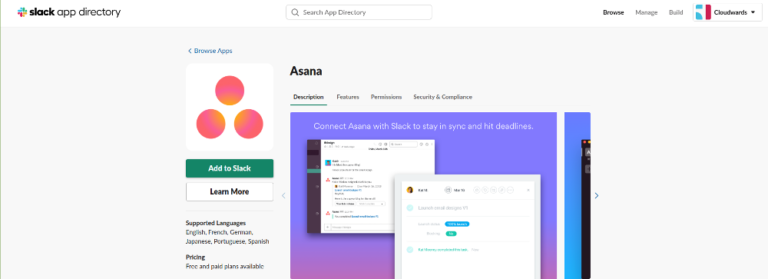
– Slack is a powerful collaboration tool and a hub of team based communication that provides a way out of the constant barrage of pointless emails, text messages, and phone calls. Difference between Asana and Slack Usability Asana is a leading team-based work management platform developed and managed by the company of the same name – Asana Inc. It also enables teams to prioritize and organize tasks, assign tasks, create reports, set deadlines, delegate tasks, upload project related documents, and do so much more. It is an all-in-one task management solution that helps teams orchestrate their work through streamlined communication and improved collaboration. Asana keeps track of all your project related tasks in one place, providing a complete view of everything from completed tasks to tasks that need to be done and everything in between. It also acts as a powerful online collaboration tool to communicate and collaborate with your team members, managers, clients, partners and vendors. It is a powerful task management tool that enables team members to track and manage their work, from start to finish. And with fewer emails, you can focus on the things that actually matter.Īsana is a flexible, easy-to-use workspace tool for project management and online collaboration. It helps organizations build valuable knowledge bases, increase productivity, and often maintain an edge over their competition. It provides some powerful features to make your work more manageable and less overwhelming. Slack is more of a team-based communication app that enables you to engage in group conversations through ‘channels’ or privately via ‘direct messaging.’ It is a fun, intuitive workspace tool that brings a relief from the constant barrage of pointless emails, text messages, and phone calls.

Slack is a chatroom which facilitates communication between team members within an organization, making it easy for them to connect and collaborate quickly if they have questions or issues. Adjust these settings now if needed.Slack is a proprietary business communication and collaboration tool that fills in the gap in modern businesses and social-team communications by bringing private messaging, group chat, and file transfer all in one place.

ASANA SLACK HOW TO
This tab provides instructions on how to create tasks and messages using email and the settings for where your emails will create tasks and messages.īy default, your email will create a task in the Workspace or Organization associated with your email address. Then, pop over to the “ Email Forwarding” tab. In Asana, click on your profile picture in the upper right-hand corner and select “ My Settings.” Only part of one Asana Workspace or Organization? Jump to step two. You’ll want to double-check your settings so that the email you send to Asana ends up in the right place. Step 1: Check your email settings.ĭon't skip this step if you’re part of more than one Asana Workspace or Organization. You can create tasks in My Tasks and Projects in Asana via email. (Guilty as charged on the sticky notes, by the way.) How to turn a Slack message into an Asana taskĭo you ever receive an email and think, “I should add that to my to-do list”? Maybe you add it to your note-taking app, jump over to Asana and add it to your tasks list, or write it down on a sticky note and hope you remember.How to create Asana tasks using Gmail and Outlook integrations.

With a few easy-to-use shortcuts, you can simplify your workflows and spend less time switching between apps. And the good news is that many of our apps, like email, Slack, and Asana, work together seamlessly. Leveraging apps to do our jobs offers more benefits than drawbacks when managed correctly. Research suggests that 76% of knowledge workers reported using more apps than five years ago, and 68% expect that number to increase. Not only is the cost of switching apps adding up, but knowledge workers are using more apps than ever in the workplace. That adds up to five working weeks in the course of a year. They found that, on average, workers toggled between different apps and websites nearly 1,200 times per day, losing over two seconds per switch. Harvard Business Review conducted a study to examine how much time and energy workers waste when switching applications and context switching.


 0 kommentar(er)
0 kommentar(er)
